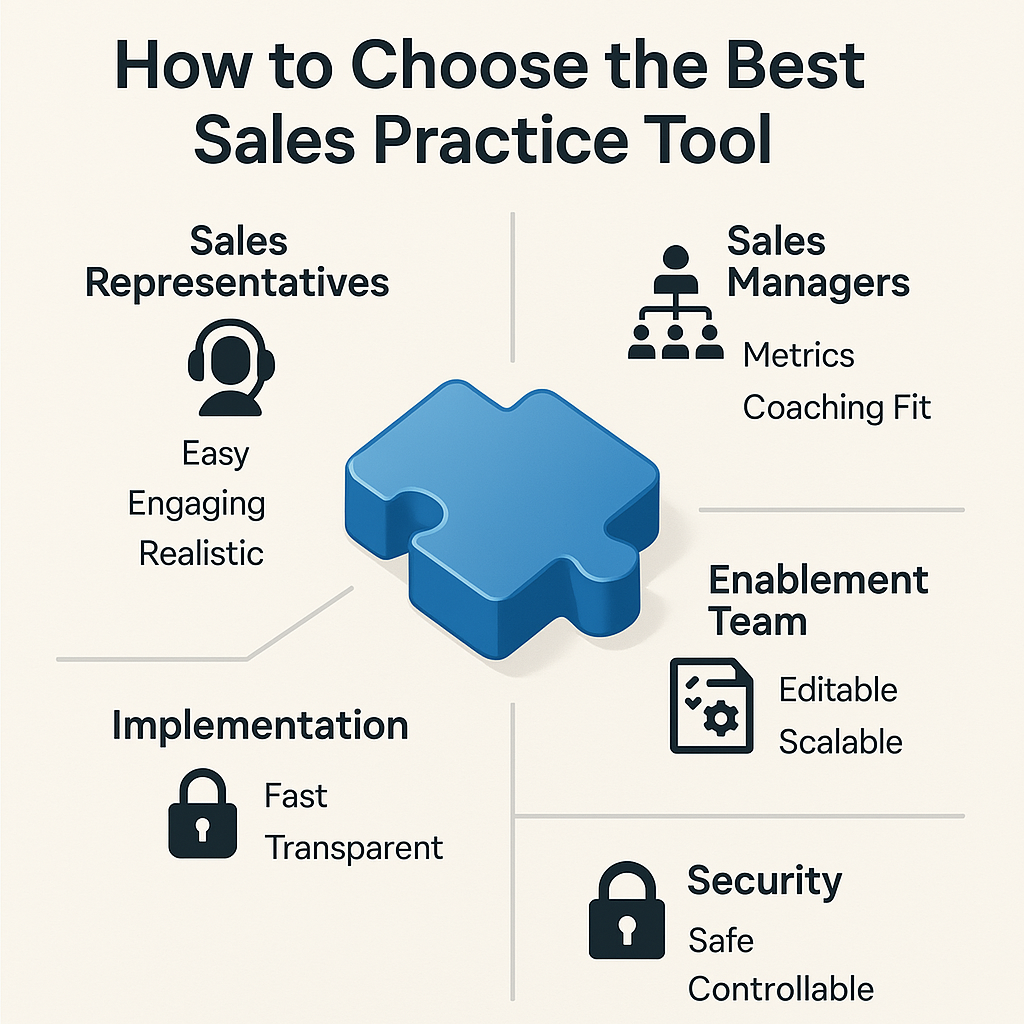· Ivelin Kozarev · Sales Technology · 6 min read
Buying Criteria for a Sales Role-Play Platform
Discover the essential criteria to consider when evaluating and comparing a sales role-play platform. Learn what features matter most and how to ensure you get the best ROI.

How do we choose the best sales role-play tool?
Ok - you have decided we want to go ahead. Picking the right partner for you is key. It can be the difference between this initiative being a success or failure.
We are going to break this down by the different roles that interact with such a tool. After all, making an initiative like this successful depends on the people who use it daily.
Sales Representatives
User-Friendliness
Is it easy to use? Sales reps already juggle many tools. The simpler it looks, the more likely they’ll use it.
Engagement Factor
Will reps actually use it? Getting people to stick with new content is tough. Look for tools with gamification or other features that keep reps coming back.
Relevance
Do the scenarios feel real? While perfect realism isn’t necessary (and might even be counterproductive), conversations should mirror actual sales calls. Otherwise, reps won’t improve.
Feedback Quality
Without the right feedback, sales reps get stuck in a loop. They can’t progress, don’t understand their scores, and eventually get frustrated. Look for tools that provide clear, actionable feedback.
Time Efficiency
Can reps use it quickly? Our tests show that practice runs over 10 minutes get 80% fewer completions. Sales folks need short, focused interactions to improve.
Sales Managers
Progress Tracking
Are there clear metrics to monitor team and individual performance? One of the biggest benefits of such a tool is time-saving for managers. Quick insights into team members’ performance puts managers in a much better position to win.
Customization
Can you tailor it to your needs? Teams focus on different things at different times. The tool should adapt to serve the right content when needed.
Coaching Integration
Does it support or enhance current coaching practices? The worst thing in a training program is teaching things different from what’s otherwise prescribed. This confuses people and reduces overall usefulness.
Tool Alignment
Similar to sales reps, managers have an overload of tasks and tools. The more complex you make the tool for them, the less likely they are to use it effectively.
Sales Enablement Team
Content Management
Is it easy to create and update scenarios? Sales teams often change training content. Making this simple for enablement leaders is key. Otherwise, this becomes another task they have to manage.
Scalability
Can it handle the entire sales force and grow with the company? While many use cases for a sales practice tool start with a specific function or initiative, the long-term goal is to get the whole sales force using it and be able to grow with added products, sales motions, etc.
Analytics
Does it show usage, progress, and ROI? As an enabler, you need to prove your initiatives work. Sales practice tools should make this easier than ever. But some make it easier.
Methodology Alignment
Can it match your sales approach? If your team uses a specific method, reinforcing it through practice is one of the biggest benefits of such tool. Otherwise, you are training people on different approaches at the same time. This never works out well.
Implementation
How long does it take? Are there hidden costs?
Some companies charge extra to set things up. Keep an eye out for these surprise fees.
What training is needed?
Every extra training session makes adoption less likely. Simpler onboarding means more people will actually use the tool.
What if we want changes?
One of the biggest traps of SaaS companies is that they get you in for a cheap price and then start adding new functionalities you have to pay for. Be mindful of this when choosing a sales practice tool. Ensure you understand the pricing structure and what’s included in your plan.
Security
Is our data safe?
This is a genuine fear for many companies looking to adopt AI technologies. It’s something you should be mindful about. Check the security policy of the company you’re considering:
- Are they looking to train their models on your data?
- Are they creating models based on your interactions?
- Are they sharing data among their clients?
Where’s our data stored?
For companies based in certain geographies, data storage location is very important from a compliance perspective. Ensure the tool’s data storage practices align with your regulatory requirements.
Can we delete our data?
While this is a necessity in geographies like the EU, it’s a best practice for you to own your data and be able to remove it from the platform in any way you want, if you decide to do so. Look for tools that give you full control over your data, including the ability to delete it completely if you end your relationship with the vendor.
Summary of Buying Criteria
Here’s a comprehensive summary of all the key criteria to consider when evaluating a sales practice platform:
| Stakeholder | Criteria | Description |
|---|---|---|
| Sales Representatives | • User-Friendliness • Engagement Factor • Relevance • Feedback Quality • Time Efficiency | • Is it easy to use? Sales reps already juggle many tools. • Will reps actually use it? Look for tools with gamification features. • Do the scenarios feel real? Conversations should mirror actual sales calls. • Look for tools that provide clear, actionable feedback. • Can reps use it quickly? Practice runs over 10 minutes get 80% fewer completions. |
| Sales Managers | • Progress Tracking • Customization • Coaching Integration • Tool Alignment | • Are there clear metrics to monitor team and individual performance? • Can you tailor it to your needs? The tool should adapt to serve the right content. • Does it support or enhance current coaching practices? • The more complex the tool, the less likely managers are to use it effectively. |
| Sales Enablement Team | • Content Management • Scalability • Analytics • Methodology Alignment | • Is it easy to create and update scenarios? Making this simple for enablement leaders is key. • Can it handle the entire sales force and grow with the company? • Does it show usage, progress, and ROI? • Can it match your sales approach? |
| Implementation | • Setup Time & Costs • Training Requirements • Change Management | • How long does it take? Are there hidden costs? • Every extra training session makes adoption less likely. • What if you want changes? Understand the pricing structure and what’s included. |
| Security | • Data Safety • Data Storage Location • Data Deletion | • Check if they train models on your data, create models based on your interactions, or share data. • Ensure the tool’s data storage practices align with your regulatory requirements. • Look for tools that give you full control over your data, including the ability to delete it completely. |
Still Not Sure If You Need a Sales Practice Platform?
While this guide helps you evaluate different sales practice platforms, you might still be wondering if your organization is ready for this investment in the first place.
Before diving into the buying criteria, it’s essential to determine if the timing is right for your team. Factors like having a champion to lead the initiative, clear examples of good and bad sales behaviors, alignment with your current sales strategy, and leadership buy-in all play crucial roles in successful implementation.
If you’re still in the decision-making phase, check out our article “When to Invest in an AI Sales Role-Play Platform?” for guidance on determining if now is the right time for your organization to adopt this technology.



